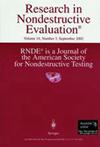Toward In-situ Characterization of Additively Manufactured Parts Using Nonlinear Resonance Ultrasonic Spectroscopy
IF 1
4区 材料科学
Q3 MATERIALS SCIENCE, CHARACTERIZATION & TESTING
引用次数: 3
Abstract
ABSTRACT In this study, we investigate the feasibility of using nonlinear resonance ultrasound spectroscopy (NRUS) for in-situ monitoring of additively manufactured (AM) parts i.e., while they are still on the build plate. In NRUS, the test specimen is excited around one or more of its resonance frequencies with increasing driving amplitude. The linear shift in resonance frequency with the increasing driving amplitude is a measure of the constituent material’s hysteretic nonlinearity (α), which is itself related to some degree of micro-damage in the test specimens. We conduct NRUS on test specimens glued to a thick plate. The specimens are excited using a piezoelectric transducer (PZT) adhered to the bottom of the plate. We use this setup to measure the hysteretic nonlinearity parameters ( and ) of several cylindrical AM specimens fabricated by laser powder bed fusion technique as well as a few non-AM metallic specimens. The measured nonlinearity parameters for the specimens on the build plate (process monitoring mode) are compared to those measured without the build plate (quality control mode). We observe a systematic decrease in the measured nonlinearity when the specimens are tested on the build plate. An analytical study demonstrates that we measure the weighted average nonlinearity of the specimen and build plate, which itself has a lower nonlinearity. Despite the observed difference, the measured nonlinearity parameters of the specimens with and without the build plate are highly correlated. With further investigations, the proposed test setup can potentially be used for characterization of AM parts in situ.利用非线性共振超声光谱技术对增材制造零件进行原位表征
在本研究中,我们研究了使用非线性共振超声光谱(NRUS)对增材制造(AM)部件进行原位监测的可行性,即当它们仍在构建板上时。在NRUS中,试件在其一个或多个谐振频率周围被激励,驱动幅值逐渐增加。共振频率随驱动幅值的增加呈线性变化,是构成材料迟滞非线性(α)的一种度量,其本身与试件中某种程度的微损伤有关。我们对粘在厚板上的测试样本进行NRUS。试样是用粘在板底部的压电换能器(PZT)进行激励的。我们使用该装置测量了几种由激光粉末床熔化技术制成的圆柱形AM样品以及一些非AM金属样品的滞后非线性参数(和)。将在构建板上(过程监控模式)测得的非线性参数与未在构建板上(质量控制模式)测得的非线性参数进行比较。我们观察到,当试件在构建板上进行测试时,测量的非线性有系统的下降。分析研究表明,我们测量了试件和构筑板的加权平均非线性,其本身具有较低的非线性。尽管观测值存在差异,但加筑板和不加筑板试件的实测非线性参数是高度相关的。随着进一步的研究,所提出的测试装置可以潜在地用于AM零件的原位表征。
本文章由计算机程序翻译,如有差异,请以英文原文为准。
求助全文
约1分钟内获得全文
求助全文
来源期刊

Research in Nondestructive Evaluation
工程技术-材料科学:表征与测试
CiteScore
2.30
自引率
0.00%
发文量
14
审稿时长
>12 weeks
期刊介绍:
Research in Nondestructive Evaluation® is the archival research journal of the American Society for Nondestructive Testing, Inc. RNDE® contains the results of original research in all areas of nondestructive evaluation (NDE). The journal covers experimental and theoretical investigations dealing with the scientific and engineering bases of NDE, its measurement and methodology, and a wide range of applications to materials and structures that relate to the entire life cycle, from manufacture to use and retirement.
Illustrative topics include advances in the underlying science of acoustic, thermal, electrical, magnetic, optical and ionizing radiation techniques and their applications to NDE problems. These problems include the nondestructive characterization of a wide variety of material properties and their degradation in service, nonintrusive sensors for monitoring manufacturing and materials processes, new techniques and combinations of techniques for detecting and characterizing hidden discontinuities and distributed damage in materials, standardization concepts and quantitative approaches for advanced NDE techniques, and long-term continuous monitoring of structures and assemblies. Of particular interest is research which elucidates how to evaluate the effects of imperfect material condition, as quantified by nondestructive measurement, on the functional performance.
 求助内容:
求助内容: 应助结果提醒方式:
应助结果提醒方式:


